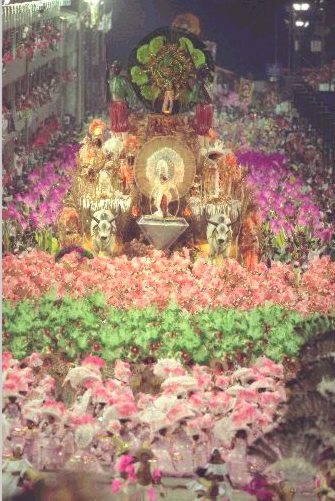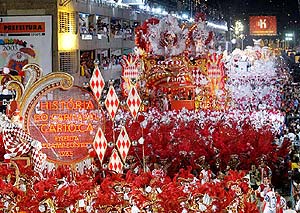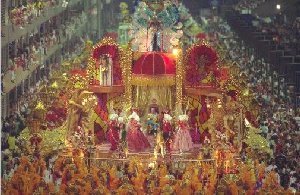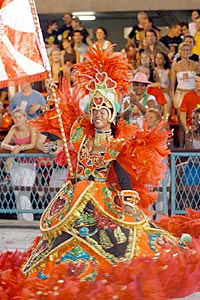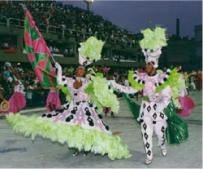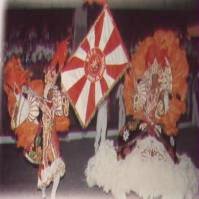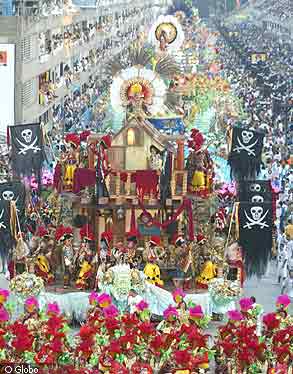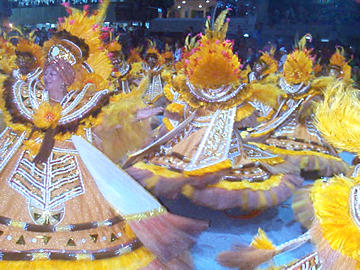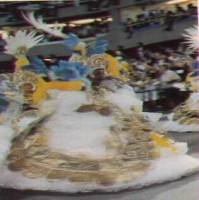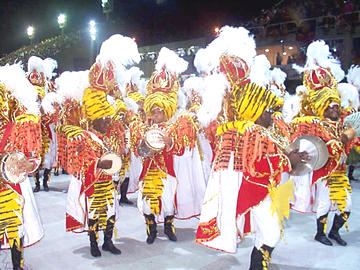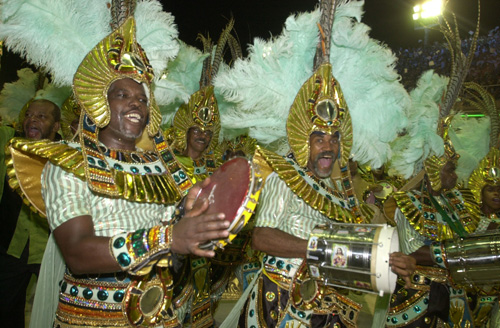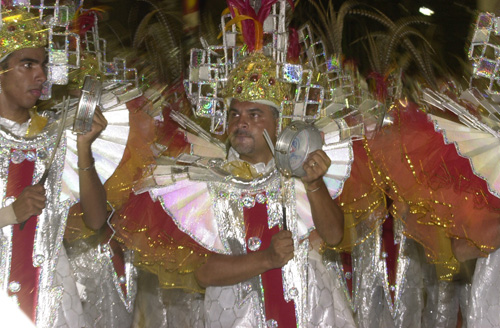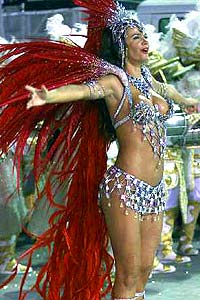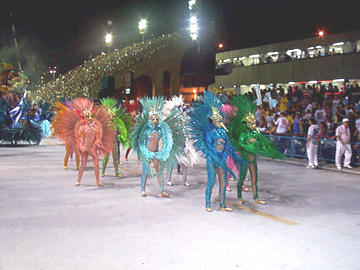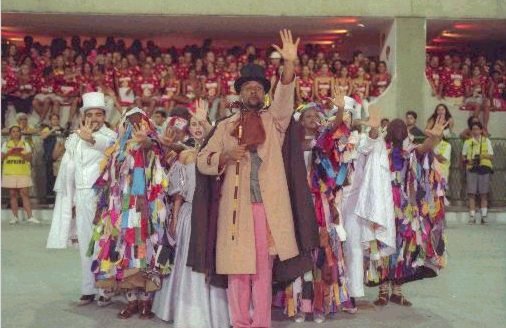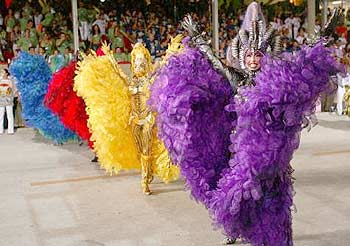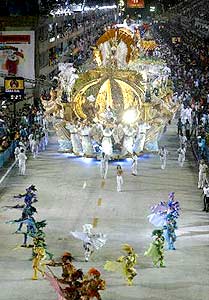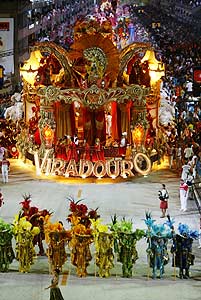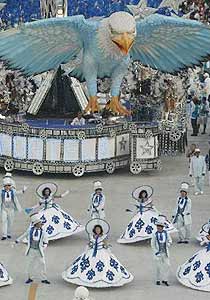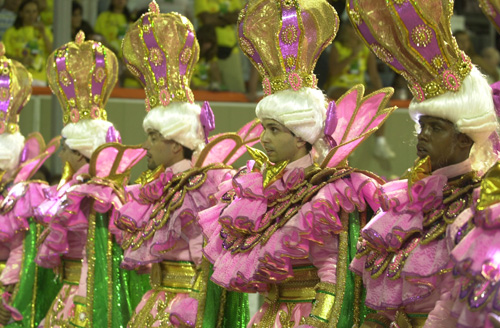|
The Judgement
During
the parades, each samba school is judged in ten different aspects
called "quesitos" (requisites). There are two major
groups among the samba schools in Rio de Janeiro, the "Grupo
Especial" (especial group) and the "Grupo de Acesso"
(access group), which is divided into groups A, B, C, D and E.
Each
year the school from the especial group that has the lowest score
descends to group A and the school from group A that has the
highest score ascends to the especial group. This happens to
all other groups too, so competition is strong. This way, each
samba school has the chance to be among the greatest schools
from the especial group one day. In addition to the requisites
that are judged, punctuallity is also fundamental. A school may
be punished for a late finish and may loose points at the final
score.
There
is a group of four jury members to appraise each "quesito"
(requisite). They place their results in an envelope, so they
cannot be revealed. On the Ash Wednesday, the envelopes are opened
at the Sambódromo and broadcasted live to Rio de Janeiro.
Each
samba school must have from six to eight floats, a group of people,
normally men, called "comissão de frente" (front
commission) that comes in the front opening the parade with a
special choreography, a very special couple known as "mestre
sala and porta-bandeira" (standard bearer and her escort,
the master of ceremonies), the "puxador de samba" (the
main singer of a samba school) and the support singers, the "bateria"
(the percussion band that accompanies the "puxador de samba"
during the parade) and a large number of people who buy the costumes
to take part in the show and form the "alas" (the units
of the school). |
© Mangueira
Marquês
de Sapucaí Avenue and the
Mangueira Samba School - Canival 2000 |
These
are the main requisites for each samba school to be on parade.
Another important fact is that the samba schools must respect
the school's colors. Each school has its own flag, that normally
consist of two colors. Of course, they make use of different
colors in the making of the costumes and floats, but the colors
of each samba school are normally clearly seen along the avenue.
Mangueira's colors are green and pink (as seen in this picture),
Salgueiro's colors are red and white, Mocidade's colors are green
and white, Beija-Flor's colors are blue and white and so on.
In
this picture you can see three "alas" from Mangueira
samba school and a float. Each "ala" is formed by groups
of people wearing the same costume. |
Below
you can see the Salgueiro samba school and its red and white
colors.
© Portal Terra
Marquês
de Sapucaí Avenue and the
Salgueiro Samba School - Canival 2003 |
© Liesa
Marquês
de Sapucaí Avenue and the
Salgueiro Samba School - Canival 2000 |
© Portal Terra
Viradouro's Standard
Bearer - Canival 2003 |
The
"porta-bandeira" (standard bearer) carries the school
standard with pride and the crowds stand and cheer as she passes
by. Her escort, the "mestre-sala" (master of ceremonies),
accompanies her with an interesting choreography, performing
the most elaborate steps around her. Together they make a very
beautiful show. |
© Globo.com
Imperatriz Leopoldinense
Samba School - Canival 2003 |
The
floats tell the story of the theme and impress everyone with
their special effects, lightning, sculptures and details. The
floats must be less than 10 meters high and 8.5 meters wide.
Each school must have from six to eight floats. In addition,
there are accessories, including hand accessories, which count
in the requisite. The floats are the requisite which mostly contributes
with new itens every year incorporating new technologies, such
as laser and many special effects. |
|
Also
important are the "baianas" section ("ala das
baianas"), that is obligatory and each school must have
at least a hundred of them. They have the attraction and affection
of the public and without them, the history of the samba would
not t be the same. Their costumes are not required to be in accordance
with the theme nor do this section have a fixed position in the
parade. |
© Liesa |
|
|
The
"baianas" are the name given to women who are born
in Bahia (a state in northern Brazil). The typical baianas use
to wear long white dresses and turbants (a tradition brought
from their African descendents). The "baianas" on the
avenue are not real "baianas" by birth, but women (mostly
aged) from the communities who perform wearing heavy "baiana"
outfits (up to 15 kg). They have to whirl on the avenue with
their large round skirts while dancing. That makes a great effect
on the avenue, especially when seen from above. |
|
The
percussion is the heart of the samba school. The person in charge
of all the instruments is called the percussion conductor, or
maestro ("mestre de bateria"). To reach this position
he must know how to play all the instruments and know the technique
of preparing the drums, have a good ear to note when something
is out of tune and gesticulate commanding his 300 percussionists. |
© Liesa
Canival 2003 |
|
During
the parade, the "bateria" comes to a space set off
to the side for the "bateria" to play in front of the
jury (this space is located half-way between the start and the
finish lines and is called "recuo da bateria"). There,
the drummers and percussionists play before the judges, while
the rest of the schools passes along the avenue. Everything must
be precise when they enter the "recuo da bateria",
so there will be no empty spaces between the "alas".
If the juries see empty spaces while the percussion is entering
or leaving the "recuo", the school loose points. Then,
after all "alas" have passed, the bateria leaves this
space and closes the parade, following the last "ala"
of the school. |
© Liesa
Percussionists
from Mangueira's "bateria" - Canival 2000
On the left is an instrument called "pandeiro" and
on the right the "cuíca".
© Liesa
Percussionists
from União da Ilha's "bateria" - Canival 2001
These instruments are called "tamborim".
© Portal Terra
Luma de Oliveira,
godmother of the
Viradouro Samba School - March, 2 2003. |
In
font of the percussion comes a woman, that can be either a black
beauty from the community or some TV star, top model or other
personality. These women are called "madrinhas de bateria"
(godmothers) and they usually come in tiny costumes or topless.
They dance the samba in front of the "bateria" during
the whole parade. |
|
The
Front Comission (Comissão de Frente) is a the group of
people who introduces the school. Many years ago, it consisted
of traditional members of the school, such as its founders, whose
function was to proudly introduce the school in song, dance and
revelry. But today it is incorporated to the theme and presents
remarkable costumes and sometimes amazing choreographies. They
often represent part of the theme like a theater play. |
© Liesa
Beija-Flor's Front
Comission with people dressed like birds
Canival 2002 |
© Mangueira
Mangueira's Front
Comission - Carnival 2000
© O Globo
Beija-Flor Front
Comission - Canival 2003
|
Below
you can see pictures of carnival 2003. On the left, Império
Serrano samba school and its front comission. On the right, the
Viradouro samba school and its front comission. Right behind
the front comissions always comes the "carro abre-alas"
(the float that "opens" the parade and carries the
school's name or symbol. |
© O Globo
Império
Serrano's Front Comision
and the "carro abre-alas" - Canival 2003 |
© O Globo
Viradouro's Front
Comision
and the "carro abre-alas" - Canival 2003 |
|
Here
you can see Portela's "carro abre-alas" and the eagle,
which is the school's symbol. In front of the "carro abre-alas"
is the front comission. |
© O Globo
Portela's Front
Comision
and the "carro abre-alas" - Canival 2003
Also
judged during the parade are:
The
samba theme song (Samba-Enredo), which tells the story or comments
on the theme. Directly influences other requisites. A samba which
the public and the people who are taking part in the parade can
sing with enthusiasm during the parade is half of the way to
a great show, although it doesn't mean that the juries will give
high notes for that school.
Harmony
(Harmonia) - not with the same meaning as in music. In this case,
harmony is a pleasing combination of related things. In a samba
school, the harmony is the perfect blend of its members' rhythm,
song and dance.
Evolution
(Evolução) - this especially observes the matching
of the different coreography and how uniform the parade is along
the avenue.
Theme
(Enredo) - the central theme of the school and its development.
The ideal is that the school has an original and creatively developed
theme.
Costumes
(Fantasias) - assessed according to their beauty, luxury and
suitability to the theme. Each school has a person in charge
of creating the prototypes for the costumes. This person is called
the "carnavalesco". People wearing the same costumes
form an "ala" of the school.
© Liesa
An "ala"
from Mangueira samba school - Canival 2001 |
 *
Back
to the Carnival in Rio Menu *
~ Miss
Price Graphics
~ Graphics by Irene ~ Country
Patch Collections
~
Nothing in this site is Public
Domain. Graphics are copyrighted by various artists and are used
with permission.
*
Back
to the Carnival in Rio Menu *
~ Miss
Price Graphics
~ Graphics by Irene ~ Country
Patch Collections
~
Nothing in this site is Public
Domain. Graphics are copyrighted by various artists and are used
with permission.
Please, click on the links above to visit the sites were you
can download the graphics from. Do not save anything from my
pages, please. |
